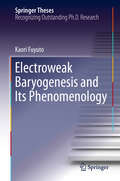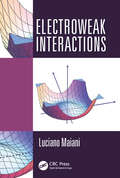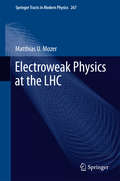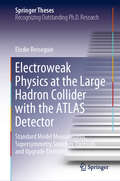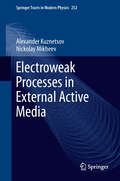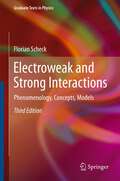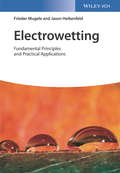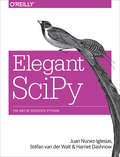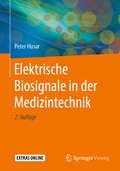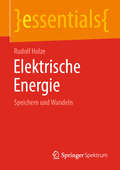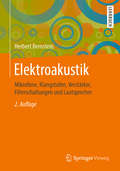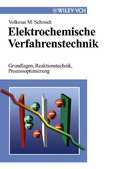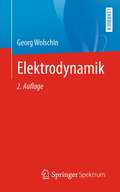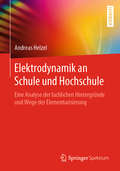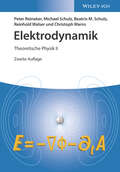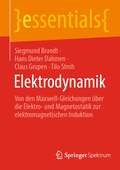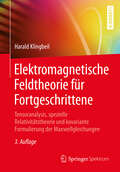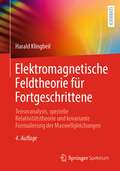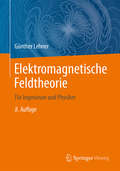- Table View
- List View
Electroweak Baryogenesis and Its Phenomenology (Springer Theses)
by Kaori FuyutoThis thesis focuses on one of the mechanisms for solving the baryon asymmetry of the Universe (BAU) which is a long-standing open question in both particle physics and cosmophysics. Electroweak baryogenesis (EWBG) is one attractive hypothetical scenario to solve this mystery because it can be verified by collider experiments. The author aims to clarify the possibility of EWBG, and to show its verifiability using the Higgs physics and electric dipole moments (EDMs) of an electron, neutron, and proton. The thesis begins with a review of the BAU and EWBG. Subsequently, the possibility of EWBG in one effective model is discussed, which can be applied to some motivated physics beyond the Standard Model. Numerical analyses of electroweak phase transition and sphaleron solution are presented, and the closed time path formalism is also explained to estimate the BAU. After essential calculations for investigation of the possibility of EWBG, the relationship between the BAU and EDMs is described. Through the discussion of the result, it is concluded that both EDMs and the Higgs physics verify the scenario completely. The whole discussion in this thesis causes us to accept the current situation that is ripe for verification of EWBG.
Electroweak Interactions
by Luciano MaianiGet First-Hand Insight from a Contributor to the Standard Model of Particle PhysicsWritten by an award-winning former director-general of CERN and one of the world's leading experts on particle physics, Electroweak Interactions explores the concepts that led to unification of the weak and electromagnetic interactions. It provides the fundamental el
Electroweak Physics at LEP and LHC
by Arno StraessnerThis up-to-date book reviews the experimental results on electroweak physics obtained at the Large Electron Positron collider, LEP, and those expected at the Large Hadron Collider, LHC. The LEP measurements are the cornerstones of precision tests of the electroweak Standard Model. The first part of the volume concentrates especially on the high-energy phase of LEP and the measurements of the mass of the W boson and the couplings between the electroweak gauge bosons, giving many details also on other physics effects like Colour Reconnection and Bose-Einstein correlations. The discussion of the recent determination of the Standard Model parameters leads eventually to the future electroweak physics at the LHC. After introducing the experimental details, the improvements envisaged with respect to today's measurements are summarized. The expectations for searches for the Standard Model Higgs boson conclude the presentation of LHC physics. The reader obtains a concise view of the present day status of electroweak physics and an outlook to the near future, illustrated with many informative figures and tables.
Electroweak Physics at LEP and LHC (Springer Tracts in Modern Physics #235)
by Arno StraessnerDuring more than 10 years, from 1989 until 2000, the LEP accelerator and the four LEP experiments, ALEPH, DELPHI, L3 and OPAL, have taken data for a large amount of measurements at the frontier of particle physics. The main outcome is a thorough and successful test of the Standard Model of electroweak interactions. Mass and width of the Z and W bosons were measured precisely, as well as the Z and photon couplings to fermions and the couplings among gauge bosons. The rst part of this work will describe the most important physics results of the LEP experiments. Emphasis is put on the properties of the W boson, which was my main research eld at LEP. Especially the precise determination of its mass and its couplings to the other gauge bosons will be described. Details on physics effects like Colour Reconnection and Bose-Einstein Correlations in W-pair events shall be discussed as well. A conclusive summary of the current electroweak measurements, including low-energy results, as the pillars of possible future ndings will be given. The important contributions from Tevatron, like the measurement of the top quark and W mass, will round up the present day picture of electroweak particle physics.This is an open access book.
Electroweak Physics at the LHC
by Matthias U. MozerThe book discusses the recent experimental results obtained at the LHCthat involve electroweak bosons. The results are placed into an appropriatetheoretical and historical context. The work pays special attention to therising subject of hadronically decaying bosons with high boosts, documentingthe state-of-the-art identification techniques and highlighting typical results. The text is not limited to electroweak physics in thestrict sense, but also discusses the use of electroweak vector-bosons as toolin the study of other subjects in particle physics, such as determinations ofthe proton structure or the search for new exotic particles. The book isparticularly well suited for graduate students, starting their thesis work ontopics that involve electroweak bosons, as the book provides a comprehensivedescription of phenomena observable at current accelerators as well as asummary of the most relevant experimental techniques.
Electroweak Physics at the Large Hadron Collider with the ATLAS Detector: Standard Model Measurement, Supersymmetry Searches, Excesses, and Upgrade Electronics (Springer Theses)
by Elodie ResseguieThis thesis discusses searches for electroweakly produced supersymmetric partners of the gauge and the Higgs bosons (gauginos and higgsinos) decaying to multiple leptons, using pp collisions at sqrt(s) = 13 TeV. The thesis presents an in-depth study of multiple searches, as well as the first 13 TeV cross section measurement for the dominant background in these searches, WZ production. Two searches were performed using 36.1/fb of data: the gaugino search, which makes use of a novel kinematic variable, and the higgsino search, which produced the first higgsino limits at the LHC. A search using 139/fb of data makes use of a new technique developed in this thesis to cross check an excess of data above the background expectation in a search using a Recursive Jigsaw Reconstruction technique. None of the searches showed a significant excess of data, and limits were expanded with respect to previous results.These searches will benefit from the addition of luminosity during HL-LHC; however, the current detector will not be able to withstand the increase in radiation. Electronics for the detector upgrade are tested and irradiated to ensure their performance.
Electroweak Processes in External Active Media
by Alexander Kuznetsov Nickolay MikheevExpanding on the concept of the authors' previous book "Electroweak Processes in External Electromagnetic Fields," this new book systematically describes the investigation methods for the effects of external active media, both strong electromagnetic fields and hot dense plasma, in quantum processes. Solving the solar neutrino puzzle in a unique experiment conducted with the help of the heavy-water detector at the Sudbery Neutrino Observatory, along with another neutrino experiments, brings to the fore electroweak physics in an active external medium. It is effectively demonstrated that processes of neutrino interactions with active media of astrophysical objects may lead, under some physical conditions, to such interesting effects as neutrino-driven shockwave revival in a supernova explosion, a "cherry stone shooting" mechanism for pulsar natal kick, and a neutrino pulsar. It is also shown how poor estimates of particle dispersion in external active media sometimes lead to confusion. The book will appeal to graduate and post-graduate students of theoretical physics with a prior understanding of Quantum Field Theory (QFT) and the Standard Model of Electroweak Interactions, as well as to specialists in QFT who want to know more about the problems of quantum phenomena in hot dense plasma and external electromagnetic fields.
Electroweak Symmetry Breaking
by Mgr. Adam SmetanaWith this thesis the author contributes to the development of a non-mainstream but long-standing approach to electroweak symmetry breaking based on an analogy with superconductivity. Electroweak symmetry breaking is assumed to be caused by dynamically generated masses of typical fermions, i. e. , of quarks and leptons, which in turn assumes a new dynamics between quarks and leptons. Primarily it is designed to generate fermion masses and electroweak symmetry breaking is an automatic consequence. After the summary of the topic, the first main part of the thesis addresses the question as to whether the masses of known quarks and leptons provide sufficiently strong sources of electroweak symmetry breaking. It is demonstrated that neutrino masses subject to the seesaw mechanism are indispensable ingredients. The other two parts of the thesis are dedicated to the presentation of two particular models: The first model is based on the new strong Yukawa dynamics and serves as a platform for studying the ability to reproduce fermion masses. The second, more realistic model introduces a flavor gauge dynamics and its phenomenological consequences are studied. Even though, in the past, this type of models has already been of some interest, following the discovery of the Standard-Model-like Higgs particle, it is regaining its relevance.
Electroweak and Strong Interactions
by Florian ScheckAfter an introduction to relativistic quantum mechanics, which lays the foundation for the rest of the text, the author moves on to the phenomenology and physics of fundamental interactions via a detailed discussion of the empirical principles of unified theories of strong, electromagnetic, and weak interactions. There then follows a development of local gauge theories and the minimal standard model of the fundamental interactions together with their characteristic applications. The book concludes with further possibilities and the theory of interactions for elementary particles probing complex nuclei. Numerous exercises with solutions make this an ideal text for graduate courses on quantum mechanics and elementary particle physics.
Electroweak-Interacting Spin-1 Dark Matter and Its Phenomenology (Springer Theses)
by Motoko FujiwaraThis book offers construction of a renormalizable effective theory of electroweak-interacting spin-1 dark matter (DM). The effective theory realizes minimal but essential features of DM predicted in extra-dimension models, and enables to systematically treat non-perturbative corrections such as the Sommerfeld effects. Deriving an annihilation cross section including the Sommerfeld effects based on the effective theory, the author discusses the future sensitivity of observations to gamma-ray from the Galactic Center. As a result, the author explains the monochromatic gamma-ray signatures originate from two photons (γγ) or photon and Z boson (γZ) produced in the process of DM annihilations, and concludes a possible scenario that unstable neutral spin-1 particles (Z’) appear and results in a spectral peak in addition to the one caused by γγ and γZ channels in gamma-ray observations. If those two spectral peaks are observed, the masses of spin-1 DM and Z’ would be reconstructed.
Electrowetting: Fundamental Principles and Practical Applications
by Frieder Mugele Jason HeikenfeldStarting from the basic principles of wetting, electrowetting and fluid dynamics all the way up to those engineering aspects relevant for the development of specific devices, this is a comprehensive introduction and overview of the theoretical and practical aspects. Written by two of the most knowledgeable experts in the field, the text covers both current as well as possible future applications, providing basic working principles of lab-on-a-chip devices and such optofluidic devices as adaptive lenses and optical switches. Furthermore, novel e-paper display technology, energy harvesting and supercapacitors as well as electrowetting in the nano-world are discussed. Finally, the book contains a series of exercises and questions for use in courses on microfluidics or electrowetting. With its all-encompassing scope, this book will equally serve the growing community of students and academic and industrial researchers as both an introduction and a standard reference.
Elegant SciPy: The Art of Scientific Python
by Harriet Dashnow Juan Nunez-Iglesias Stéfan van der WaltWelcome to Scientific Python and its community. If you’re a scientist who programs with Python, this practical guide not only teaches you the fundamental parts of SciPy and libraries related to it, but also gives you a taste for beautiful, easy-to-read code that you can use in practice. You’ll learn how to write elegant code that’s clear, concise, and efficient at executing the task at hand.Throughout the book, you’ll work with examples from the wider scientific Python ecosystem, using code that illustrates principles outlined in the book. Using actual scientific data, you’ll work on real-world problems with SciPy, NumPy, Pandas, scikit-image, and other Python libraries.Explore the NumPy array, the data structure that underlies numerical scientific computationUse quantile normalization to ensure that measurements fit a specific distributionRepresent separate regions in an image with a Region Adjacency GraphConvert temporal or spatial data into frequency domain data with the Fast Fourier TransformSolve sparse matrix problems, including image segmentations, with SciPy’s sparse modulePerform linear algebra by using SciPy packagesExplore image alignment (registration) with SciPy’s optimize moduleProcess large datasets with Python data streaming primitives and the Toolz library
Elektrische Biosignale in der Medizintechnik
by Peter HusarDas grundlegende Kompendium führt in das zunehmend wichtiger werdende Thema der Biosginalverarbeitung ein. Der inhaltliche Aufbau orientiert sich an der Abfolge der diagnostischen Kette: von Sensorik, Signalverstärkung und -konditionierung über Signalabtastung und -digitalisierung, Methoden der Biosignalverarbeitung bis zu Auswertung und Diagnosevorschlag. Dabei liefert jedes Kapitel das entsprechende theoretische und methodische Wissen, behandelt Realisierungsalternativen und stellt Praxisbeispiele sowie die aktuell verfügbare Technik vor.
Elektrische Energie: Speichern und Wandeln (essentials)
by Rudolf HolzeRudolf Holze stellt in diesem essential Möglichkeiten, Systeme und Verfahren der Wandlung elektrischer Energie in andere Energieformen wie auch aus diesen zurück in elektrische Energie mit einem Schwerpunkt auf elektrochemischen Verfahren vor. Der Autor erläutert ausgewählte Beispiele ausführlich unter Einbeziehung grundlegender Erkenntnisse der Elektrochemie. Aufgrund der besonderen Bedeutung dieser Speicher und Wandler in einer sich ändernden Energielandschaft, die durch eine rasch zunehmende Einbeziehung erneuerbarer Energiequellen und die noch immer wachsende Zahl mobiler und netzunabhängiger Anwendungen elektrischer Energie gekennzeichnet ist, werden diese Aspekte besonders berücksichtigt. In dieser komplexer werdenden Landschaft vermittelt das essential Orientierung und grundlegende Informationen zum besseren Verständnis und zur sachlichen Diskussion.
Elektrische Energieversorgung 2: Energiewirtschaft und Klimaschutz, Elektrizitätswirtschaft und Liberalisierung, Kraftwerktechnik und alternative Stromversorgung, chemische Energiespeicherung
by Valentin Crastan Michael HöckelDer hier vorliegende zweite Band des dreiteiligen Werkes „Elektrische Energieversorgung“ widmet sich den Aufgaben der Energiewirtschaft inklusive der Aspekte zum Klimaschutz sowie der Beschaffenheit des Energiemarktes. Kraftwerktechnik sowie Anlagen zur Stromerzeugung aus regenerativen Energiequellen und Energiespeicherung runden diesen Band im Bereich Elektrizitätswirtschaft ab.Alle drei Bände Elektrische Energieversorgung zeichnen sich durch die Synthese von theoretischer Fundierung und unmittelbarem Praxisbezug aus. Sie unterstützen das Verständnis und den Lernerfolg mit Übungsaufgaben, Modellbeispielen bzw. Simulationen.
Elektroakustik: Mikrofone, Klangstufen, Verstärker, Filterschaltungen und Lautsprecher
by Herbert BernsteinDieses Buch bietet eine Zusammenfassung von physikalischen und elektronischen Zusammenhängen der Akustik. Zunächst behandelt es ausführlich die Grundlagen der Akustik. Auf dieser Basis beschreibt der Autor Mikrofone und Vorverstärker. Die Berechnung von aktiven und passiven Filterschaltungen sowie die Vorstellung der verschiedenen Betriebsarten von NF-Leistungsverstärkern vermitteln die notwendigen Kenntnisse der Elektronik. Darauf aufbauend folgen die Beschreibung und Berechnungen von aktiven und passiven Frequenzweichen. Die Beschreibung und Berechnungen von Lautsprecherkombinationen runden das inhaltliche Konzept des Buches ab und ermöglichen dem Leser somit die Einarbeitung in den ganzen Bereich der Elektroakustik.
Elektrochemische Verfahrenstechnik: Grundlagen, Reaktionstechnik, Prozessoptimierung
by Volkmar M. SchmidtDieses Buch bringt dem Leser das Themengebiet der elektrochemischen Verfahrenstechnik in präziser und aktueller Form nahe: mit Beispielen und Aufgaben mit Lösungen werden sowohl dem Einsteiger die theoretischen Grundlagen der Elektrochemie vermittelt, als auch der Fortgeschrittene von der Verfahrensentwicklung zur modernen elektrochemischen Verfahrenstechnik in Anwendung und Praxis geleitet. Der dargebotene Themenbereich umfasst Galvanotechnik, organische und anorganische elektrochemische Produktionsverfahren, wichtige Elektrolyseverfahren sowie Batterien und Brennstoffzellen, und wendet sich damit an Studierende und Berufseinsteiger in Forschung, Entwicklung und Produktion, die einen guten und schnellen Überblick über die Materie gewinnen wollen.
Elektrodynamik
by Georg WolschinDieses Buch umfasst ausgewählten Vorlesungsstoff der Theoretischen Physik: Elektrodynamik für Studierende im Grundstudium. Nach einer Einführung in die Grundbegriffe und die Maxwell’schen Gleichungen folgen Kapitel über Elektrostatik und Magnetostatik. Anschließend wird die spezielle Relativitätstheorie als Konsequenz der Lorentz-invarianten Maxwell-Theorie vorgestellt, so dass im folgenden Kapitel die vierdimensionale Formulierung der Elektrodynamik mit Feldstärketensor, Energie-Impuls-Tensor sowie die Lagrange-Formulierung eingeführt werden kann. Elektromagnetische Wellen werden im Vakuum und in Materie untersucht, sowie Wellenpakete und die Reflexion und Brechung an Grenzflächen studiert. Die Felder bewegter Ladungen, die zugehörigen Liénard-Wiechert Potenziale für bewegte Punktladungen und die Larmor-Formel leiten über zum Hertz’schen Dipol. Die durch den schwingenden Dipol erzeugten Felder folgen hier aus den zeitabhängigen Potenzialen.Anhand von insgesamt über 40 Testaufgaben mit Lösungen am Ende der Kapitel wird der Leser dazu motiviert, den Stoff selbst beispielhaft nachzurechnen und das Gelernte zu festigen.
Elektrodynamik an Schule und Hochschule: Eine Analyse der fachlichen Hintergründe und Wege der Elementarisierung
by Andreas HelzelDieses Lehrbuch analysiert die konzeptionelle Umsetzung und Stoffauswahl zur Elektrizitätslehre und Elektrodynamik an Schule und Hochschule und gibt einen reflektierten fachwissenschaftlichen Überblick, der die Entwicklung einer fach- und schülergerechten und anschlussfähigen Elementarisierung unterstützt. Jedes Kapitel gibt themenspezifisch zunächst einen Überblick der Inhalte für Schule und Hochschule. Dazu dienen Lehrpläne und Schulbücher der Sekundarstufe I und II sowie verschiedene Lehrbücher. Der Autor analysiert und diskutiert anschließend schulische und hochschulische Darstellungsweisen und Inhalte im Vergleich und stellt Elementarisierungsmöglichkeiten dar. Damit werden fachwissenschaftliche Inhalte auf schulischem und hochschulischem Niveau systematisiert, verglichen und diskutiert. Es geht dabei nicht um pauschale ideale Elementarisierungen, sondern es soll vor allem ein kritisch-reflexiver Blick auf fachwissenschaftlicher Ebene geschult werden. So unterstützt es bei der Gestaltung einer situationsspezifischen Elementarisierung, bezogen auf länderspezifische Lehrpläne, Jahrgangsstufe und konkrete Schülerschaft. Das Lehrbuch richtet sich an alle, die die Fachphysik lehramtsspezifisch reflektieren oder eine Elementarisierung gestalten möchten: Studierende, die ihr fachwissenschaftliches Studium im Kontext ihrer zukünftigen Profession sehen wollen, Lehrende, die einen derartigen Kurs anbieten und Forschende auf diesem Gebiet. Thematisch behandelt das Buch die üblichen Inhalte der hochschulischen Elektrodynamik und ihre Pendants in der Schule. Somit finden sich neben den Themen der Elektro-, Magnetostatik und Elektrodynamik auch Kapitel zu Optik (Beugung und Interferenz) und der speziellen Relativitätstheorie.
Elektrodynamik: Theoretische Physik II
by Michael Schulz Peter Reineker Reinhold Walser Beatrix M. Schulz Christoph WarnsDie Neuauflage gibt eine Einführung in die konzeptionell und mathematisch anspruchsvolle Elektrodynamik. Ausgehend von experimentellen Erkenntnissen über elektrische und magnetische Felder werden die Studierenden an die Maxwell-Gleichungen im Vakuum und in Materie herangeführt.
Elektrodynamik: Von den Maxwell-Gleichungen über die Elektro- und Magnetostatik zur elektromagnetischen Induktion (essentials)
by Hans Dieter Dahmen Siegmund Brandt Claus Grupen Tilo StrohDieses essential konzentriert sich auf die Vermittlung der wichtigsten Grundbegriffe, von der Elektrostatik, den Phänomenen des elektrischen Stromes bis hin zu den Maxwell-Gleichungen und aus ihnen abgeleiteten Erkenntnissen. Begriffe wie Ladung, Coulomb-Kraft, Dipol, elektrisches Feld und Potential, magnetisches Feld, Lorentz-Kraft und die Wechselbeziehungen zwischen elektrischen und magnetischen Feldern wie die Induktion werden dargestellt. Auf die vielen Anwendungen der Elektrodynamik wird hingewiesen.
Elektromagnetische Feldtheorie für Fortgeschrittene: Tensoranalysis, spezielle Relativitätstheorie und kovariante Formulierung der Maxwellgleichungen
by Harald KlingbeilDieses Buch bietet einen behutsamen Einstieg in die Tensoranalysis, in die Grundlagen der speziellen Relativitätstheorie und in die relativistische Formulierung der Elektrodynamik. Die Maxwell’schen Gleichungen im Vakuum und die kovariante Form der Maxwellgleichungen werden intensiv behandelt. Auch Dipole und die Abstrahlung elektromagnetischer Wellen bilden inhaltliche Schwerpunkte.Mathematisch präzise und durch ausführliche Rechnungen leicht verständlich, stellt das Buch eine Verbindung zwischen Elektrotechnik, Mathematik und Physik her. Für diesen Vertiefungsband ist ein Grundwissen der Elektrodynamik hilfreich, wie es im Band „Grundlagen der elektromagnetischen Feldtheorie — Maxwellgleichungen, Lösungsmethoden und Anwendungen“ des Autors oder vergleichbaren Lehrbüchern vermittelt wird.Übungsaufgaben mit ausführlichen Musterlösungen vertiefen den Stoff und helfen bei der Kontrolle des Lernerfolgs. Ein umfangreicher Tabellenteil am Ende des Buchs erlaubt die Nutzung als Nachschlagewerk.
Elektromagnetische Feldtheorie für Fortgeschrittene: Tensoranalysis, spezielle Relativitätstheorie und kovariante Formulierung der Maxwellgleichungen
by Harald KlingbeilDieses Buch bietet einen behutsamen Einstieg in die Tensoranalysis, in die Grundlagen der speziellen Relativitätstheorie und in die relativistische Formulierung der Elektrodynamik. Die Maxwell’schen Gleichungen im Vakuum und die kovariante Form der Maxwellgleichungen werden intensiv behandelt. Auch Dipole und die Abstrahlung elektromagnetischer Wellen bilden inhaltliche Schwerpunkte.Mathematisch präzise und durch ausführliche Rechnungen leicht verständlich, stellt das Buch eine Verbindung zwischen Elektrotechnik, Mathematik und Physik her. Für diesen Vertiefungsband ist ein Grundwissen der Elektrodynamik hilfreich, wie es im Band „Grundlagen der elektromagnetischen Feldtheorie — Maxwellgleichungen, Lösungsmethoden und Anwendungen“ des Autors oder vergleichbaren Lehrbüchern vermittelt wird.Übungsaufgaben mit ausführlichen Musterlösungen vertiefen den Stoff und helfen bei der Kontrolle des Lernerfolgs. Ein umfangreicher Tabellenteil am Ende des Buchs erlaubt die Nutzung alsNachschlagewerk.In der vorliegenden vierten Auflage wurden zahlreiche Themen überarbeitet, neue hinzugefügt sowie an vielen Stellen kleinere Ergänzungen des Textes vorgenommen, um die Verständlichkeit weiter zu erhöhen und die Darstellung zu vervollständigen.
Elektromagnetische Feldtheorie: Für Ingenieure und Physiker
by Günther Lehner Stefan KurzDie elektromagnetische Feldtheorie ist ein für Ingenieure und Naturwissenschaftler grundlegendes Wissensgebiet, das die Gesetzmäßigkeiten elektrischer und magnetischer Felder und Wellen beschreibt. In diesem didaktisch ausgearbeiteten Lehrbuch werden die elektromagnetische Feldtheorie und die dafür erforderlichen mathematischen Methoden vermittelt. Dafür hat der Autor die Lehrinhalte möglichst anschaulich aufbereitet, die Begriffsbildungen und Ableitungen legt er äußerst genau dar.Zu Beginn werden die Maxwellschen Gleichungen, die die Grundlage der klassischen Elektrodynamik bilden, vorgestellt und erläutert. Es folgen Ausführungen über Elektrostatik, Strömungsprobleme, Magnetostatik, quasistationäre Felder und elektromagnetische Wellen. Der Autor behandelt die Anwendung numerischer Methoden wie finite Differenzen, finite Elemente (FEM), Randelemente, Ersatzladungsmethoden und Monte-Carlo-Methoden auf feldtheoretische Probleme. Darüber hinaus gibt er immer wieder Ausblicke auf grundlegende, zum Teil noch offene Fragen der Physik bis hin zur Quantenmechanik. Ein Kapitel widmet sich der Relativitätstheorie, die Maxwells klassische Elektrodynamik erweitert. Denn mithilfe von Einsteins Theorie lassen sich zahlreiche Probleme der elektromagnetischen Feldtheorie leichter lösen.Das Lehrbuch richtet sich an Studierende der ingenieurwissenschaftlichen Fächer und der Physik. Aber auch Studierende anderer naturwissenschaftlicher Fachrichtungen profitieren von diesem Standardwerk zur elektromagnetischen Feldtheorie. Ein Verzeichnis der Symbole und ein Sachverzeichnis erleichtern die Handhabung des Buchs und unterstützen das Lernen.
Elektromagnetische Feldtheorie: für Ingenieure und Physiker
by Günther Lehner Stefan KurzDie elektromagnetische Feldtheorie ist ein für Ingenieure und Naturwissenschaftler grundlegendes Wissensgebiet, das die Gesetzmäßigkeiten elektrischer und magnetischer Felder und Wellen beschreibt. In diesem didaktisch ausgearbeiteten Lehrbuch werden die elektromagnetische Feldtheorie und die dafür erforderlichen mathematischen Methoden vermittelt. Dafür hat der Autor die Lehrinhalte möglichst anschaulich aufbereitet, die Begriffsbildungen und Ableitungen legt er äußerst genau dar.Zu Beginn werden die Maxwellschen Gleichungen, die die Grundlage der klassischen Elektrodynamik bilden, vorgestellt und erläutert. Es folgen Ausführungen über Elektrostatik, Strömungsprobleme, Magnetostatik, quasistationäre Felder und elektromagnetische Wellen. Der Autor behandelt die Anwendung numerischer Methoden wie finite Differenzen, finite Elemente (FEM), Randelemente, Ersatzladungsmethoden und Monte-Carlo-Methoden auf feldtheoretische Probleme. Darüber hinaus gibt er immer wieder Ausblicke auf grundlegende, zum Teil noch offene Fragen der Physik bis hin zur Quantenmechanik. Ein Kapitel widmet sich der Relativitätstheorie, die Maxwells klassische Elektrodynamik erweitert. Denn mithilfe von Einsteins Theorie lassen sich zahlreiche Probleme der elektromagnetischen Feldtheorie leichter lösen. Das Lehrbuch richtet sich an Studierende der ingenieurwissenschaftlichen Fächer und der Physik. Aber auch Studierende anderer naturwissenschaftlicher Fachrichtungen profitieren von diesem Standardwerk zur elektromagnetischen Feldtheorie. Ein Verzeichnis der Symbole und ein Sachverzeichnis erleichtern die Handhabung des Buchs und unterstützen das Lernen.
